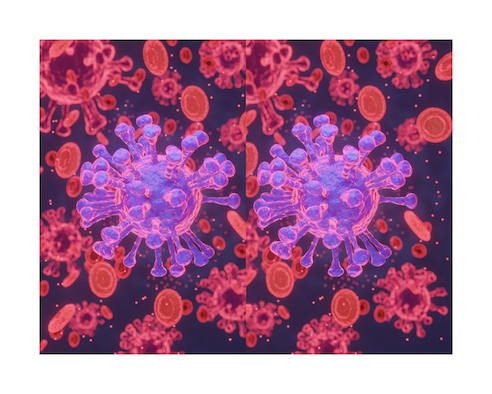Stay updated on what is trending in health. Discover tips and resources for a healthier, balanced life.
The Difference Between HIV and AIDS
Discover the key differences between HIV & AIDS, including symptoms, early diagnosis, antiretroviral therapy (ART), progression, prevention & complications
DISEASES AND CONDITIONS
Dr. S. Ali
9/28/20254 min read


You’ve probably heard the terms HIV and AIDS used together so often that they sound like the same thing—but they’re actually quite different. Understanding the difference between HIV (Human Immunodeficiency Virus) and AIDS (Acquired Immunodeficiency Syndrome) is super important for awareness, prevention, and treatment.
So let’s break it down in a simple, easy-to-follow way.
What Exactly Is HIV?
HIV is a virus that targets your immune system—specifically, your CD4 cells (also called T cells). These are the good guys that help fight off infections. If HIV isn’t treated, it keeps attacking these cells, making it harder for your body to stay healthy and fight off diseases.
The good news? With the right treatment, most people with HIV can live long, healthy lives.
And What About AIDS?
AIDS is the most advanced stage of HIV. It happens when HIV has caused so much damage to your immune system that it can’t protect you anymore. This is when people become more vulnerable to serious infections and certain cancers.
Think of it this way: HIV is the virus, and AIDS is what can happen if HIV isn’t managed properly over time.
Key Differences Between HIV and AIDS
Here’s a quick breakdown to make it even clearer:
HIV is the virus; AIDS is the result of the virus going untreated.
HIV attacks your immune system over time. AIDS is when your immune system is severely weakened (CD4 count drops below 200).
HIV symptoms might include fatigue, swollen lymph nodes, and weight loss.
AIDS symptoms can be more serious—like chronic diarrhea, night sweats, rapid weight loss, and recurring infections.HIV is treatable with antiretroviral therapy (ART). If someone progresses to AIDS, treatment still helps, but the immune system is already very weak.
Symptoms: What to Look Out For
Early HIV Symptoms (usually show up 2–4 weeks after exposure):
Fever
A mild to high fever is often the first sign of the body’s immune system reacting to the virus. It may come and go over several days.Chills
Sudden shaking or chills can accompany fever and make the person feel extremely weak or uncomfortable.Rash
A red, itchy skin rash—often on the chest, face, or limbs—can develop. It may last for days or weeks and sometimes appears without other symptoms.Muscle aches
Generalized body aches and joint pain can occur, much like when you have the flu, and may make daily tasks feel exhausting.Sore throat
Persistent throat pain or difficulty swallowing can happen as the virus spreads and the immune system becomes more active.Swollen lymph nodes
Lymph nodes in the neck, armpits, or groin may swell as the body tries to fight the infection, making them tender to the touch.Night sweats
Profuse sweating during sleep—enough to soak clothes or bedding—can occur even without fever and is a common early sign.
These early signs often feel like the flu, which is why HIV can go unnoticed for a while.
AIDS Symptoms (when HIV progresses without treatment):
Significant weight loss
Often referred to as “wasting,” this can happen even with adequate food intake, as the body struggles to absorb nutrients.Persistent fever
Ongoing or recurring fevers may signal the body’s inability to fight off infections due to a weakened immune system.Chronic diarrhea
Long-lasting diarrhea can lead to dehydration, nutrient loss, and severe weakness, making daily life difficult.Skin rashes or sores
Painful skin lesions, mouth ulcers, or genital sores may develop, often linked to opportunistic infections or cancers like Kaposi’s sarcoma.Frequent infections
Common illnesses such as pneumonia, tuberculosis, or fungal infections occur more often and are harder to treat.Memory issues or other neurological problems
HIV can affect the brain, leading to memory loss, confusion, difficulty concentrating, or even conditions like HIV-associated dementia.
How Does HIV Progress to AIDS?
Here’s the thing—not everyone with HIV will develop AIDS. With early diagnosis and consistent treatment, HIV can be managed and kept from ever turning into AIDS.
But without treatment, HIV may progress to AIDS in about 8–10 years—or sometimes even sooner.
How Is HIV Spread?
HIV is spread through certain body fluids, including:
Unprotected sex (vaginal, anal, or oral)
Sharing needles or syringes
From mother to baby during childbirth or breastfeeding
Blood transfusions (extremely rare now due to screening)
Can HIV/AIDS Be Treated?
Yes, absolutely. While there’s no cure yet, HIV is treatable. Antiretroviral therapy (ART) helps control the virus, boosts your immune system, and reduces the risk of transmission.
People living with HIV who stay on treatment can live long, healthy, and full lives.
How Can You Prevent HIV?
Great question. Prevention matters, and there’s a lot you can do:
Use condoms every time you have sex
Get tested regularly for HIV and other STDs
Don’t share needles or syringes
If you're at higher risk, consider PrEP (Pre-Exposure Prophylaxis)—a daily pill that helps prevent HIV
Pregnant women with HIV should get proper care to prevent passing it to the baby
The Bottom Line
HIV and AIDS are connected, but they’re not the same thing. HIV is the virus that causes damage, and AIDS is what happens when that damage goes untreated. But the most important takeaway? HIV is manageable, especially if caught early.
With the right information, care, and prevention, it’s totally possible to live well and avoid complications. Stay informed, take precautions, and help spread awareness.
Sources:
HIV.gov
https://www.hiv.gov/hiv-basics/overview/about-hiv-and-aids/how-is-hiv-transmitted
National Institutes of Health (NIH)
HIV and AIDS Basics; https://hivinfo.nih.gov/understanding-hiv/fact-sheets/hiv-and-aids-basics
Center for Disease Control and Prevention (CDC):
About HIV; https://www.cdc.gov/hiv/index.html
Johns Hopkins Medicine:
HIV and AIDS Overview; https://www.hopkinsmedicine.org/health/conditions-and-diseases/hiv-and-aids
Pulse Your Health
Empowering you to achieve your health goals.
Contact
© 2025. All rights reserved.
Disclaimer: The content on this website is for informational purposes only and is not medical advice. Always seek the advice of your physician or other suitably qualified healthcare professional for diagnosis, treatment and your health related needs.
